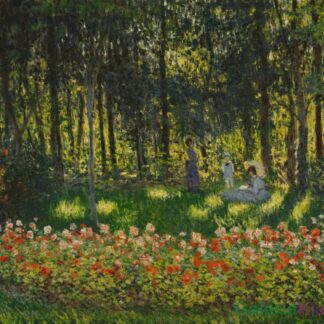- 15 min
The story of Impressionism starts in Paris in the 1860s. It was then that the four friends who studied together – Claude Monet, Pierre-Auguste Renoir, Alfred Sisley, and Frédéric Bazille –found out that they had something in common: they loved to paint landscapes and scenes from modern life, and at the same time they chafed at following the rigid rules of Academism. The huge and complex scenes of mythological or religious subjects that were being promoted by the French Academy of Fine Arts in Paris, which ruled the artistic scene at the time, just weren’t for them. They wanted to paint what was in front of them, absolutely normal and un-heroic subjects: meadows full of flowers, haystacks, bridges, trains, light effects on water, people chilling out and having fun in public parks, people in the theatres, and women looking after their children.

1. Thomas Couture, The Romans in their Decadence, 1847, Musée d’Orsay, Paris, France.
This painting, which won the Salon of 1847, is typical of the French Academy style from between 1850 and 1900. It is large (472 x 772 cm) and shows a scene from ancient times that represents human behaviour and conveys a moral message.
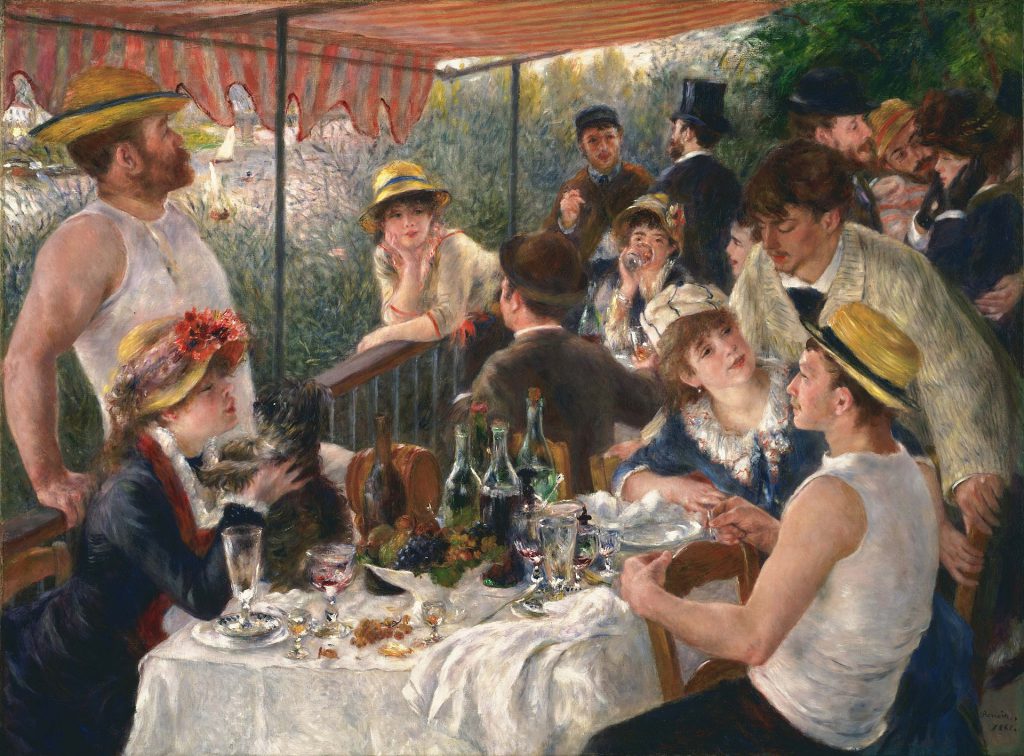
2. Pierre-Auguste Renoir, Luncheon of the Boating Party, 1880-1881, The Phillips Collection, Washington, D.C., United States.
This is a classic impressionistic scene – regular people outdoors, chilling out. Renoir painted his friends here – we can spot Gustave Caillebotte who sits with his back towards us in his chair, staring across the table at Aline Charigot, Renoir’s future wife, who is cooing to her terrier.
The subjects the Impressionists choose were bold statements. At that time, money, career, and fame belonged to those artists who followed strictly delineated schemes dictated by the Academy. As an artist, if you didn’t want to follow them but still wanted to be somehow recognised, you had to have the nerve and marketing abilities of Gustave Courbet. Luckily, the Impressionists had a lot of nerve and some smart people around them who believed in this “new” art. And later, in the 1890s, they had the United States of America. We will talk about this later.
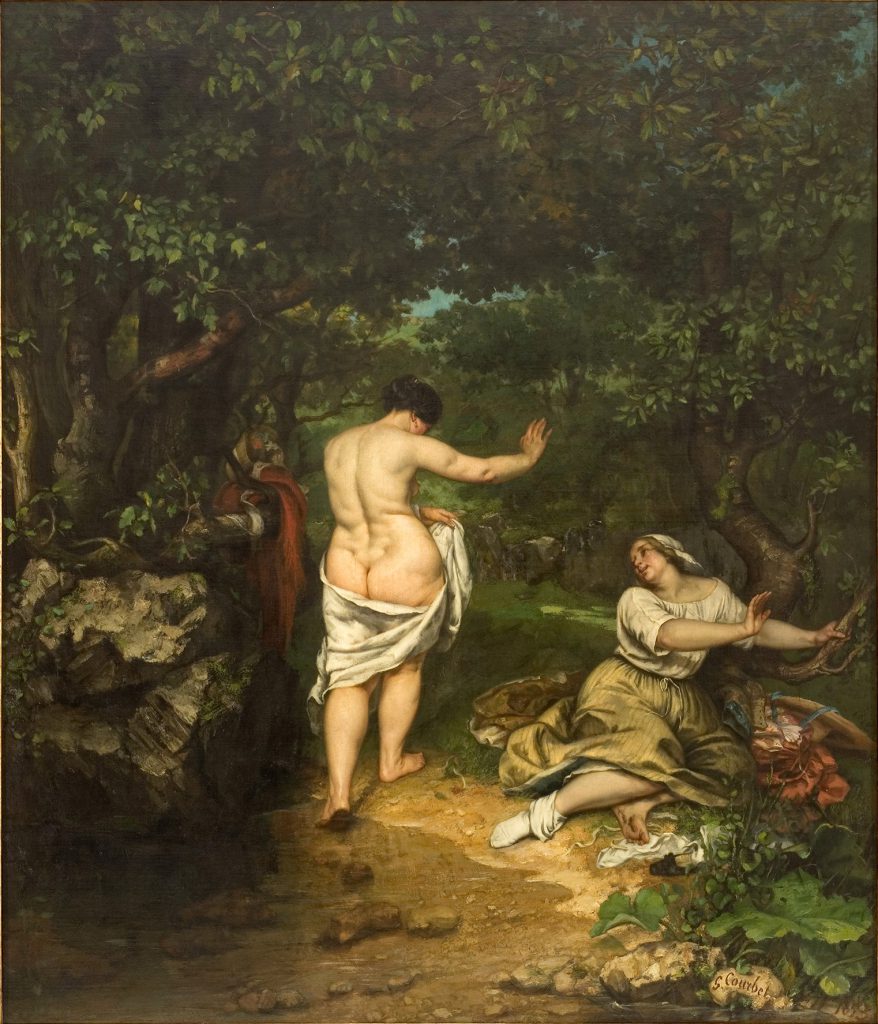
3. Gustave Courbet, The Bathers, 1853, Musée Fabre, Montpellier, France.
Courbet was a man who caused many artistic scandals. Among them was this painting, which was first exhibited at the Paris Salon of 1853. It was unanimously attacked by art critics for the huge nude woman at its centre and the sketchy landscape background, both of which went against official artistic canon. In 1855, after his painting-manifesto “The Artist’s Studio” had been rejected by the Salon, Courbet decided to organise a personal exhibition alongside the Universal Exhibition in a building which he had built at his own expense and named “The Pavilion of Realism”.
The Impressionist revolution was not only about subjects that were previously absent in art. The basic aim of the Impressionists was to depict on canvas exactly what they saw in a particular moment. To grasp that moment in a painting. To reach that goal, they had to start painting in a new way. They used short, thick strokes of paint to capture the essence of the subject rather than the details. Quickly applied brush strokes gave the illusion of movement and spontaneity. It was all possible thanks to a new technological invention from the 1840s; synthetic paint in tubes. It is hard to believe it now, but until the 19th century all landscapes, even those that look very “natural” and “real”, were created in artists’ studios. Synthetic paints in tubes allowed outdoors to paint… outdoors. En plein air we can say.

4. Berthe Morisot, Young Woman in Grey Reclining, 1879, private collection.
Berthe Morisot was one of the Impressionists and she took the idea of grasping the moment most seriously. Some incredibly sketchy parts of her paintings could be called “abstract”.
The painters were also inspired by photography and Japanese art, which encouraged them to open the composition of their paintings or cut it in a way previously unseen in European art.

5. Gustave Caillebotte, Le Pont de l’Europe, 1876–77, Kimbell Art Museum, Fort Worth, United States.
Gustave Caillebotte has only recently found proper recognition as a first-class impressionist. Previously, he was mostly seen as a supporter and collector of their paintings. The framing of his paintings is clearly inspired by the trends in photography that were taking place at the time.
The keywords of Impressionism are sensuality and transience. How to depict the light of the summer sunset on a Gothic facade? Or the sparkling light reflected in the water of a Venetian canal? The movement of a ballerina spinning in a dance? The Impressionists tried to capture ever-changing reality and perpetuate the subjective, fleeting impressions that left them breathless.
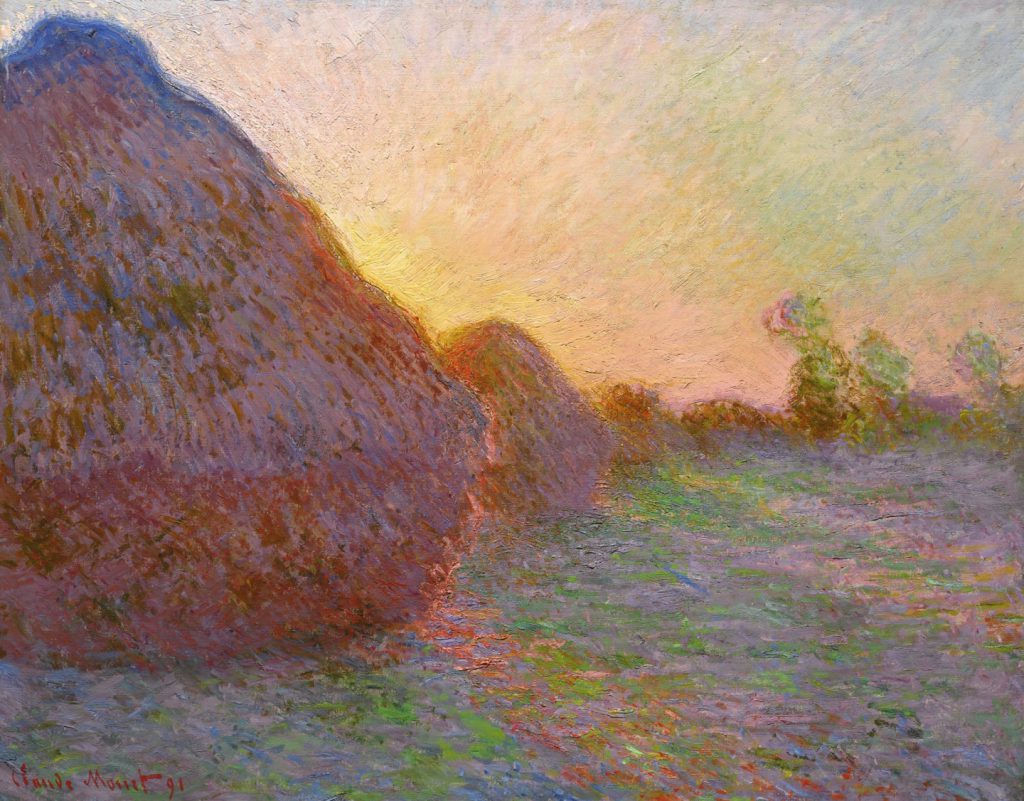
6. Claude Monet, Meules, 1890, private collection.
This painting from Monet’s famous “Haystacks” series was auctioned at Sotheby’s in 2019 for $110.7 million. “Haystacks” is one of the icons of Impressionism and among the greatest examples of how Monet was obsessed with the idea of capturing the moment.
Today the prices of Impressionist paintings reach unbelievable sums ($110.7 million again for “Meules” by Claude Monet!). But it wasn’t always like this. At the beginning, they didn’t earn much money for their art and they were mocked and marginalised. The name of the movement itself was a joke, coined by the art critic Louis Leroy who wanted to make fun of the artists exhibiting their works in Nadar’s famous photography studio in May 1874. He took it from the title of one of Monet’s paintings, “Impression, Sunrise”. However, it is thanks to that painting that the movement took its name and soon became popular not only in France but also in other distant parts of the world, ending up influencing music, literature and even cinema.
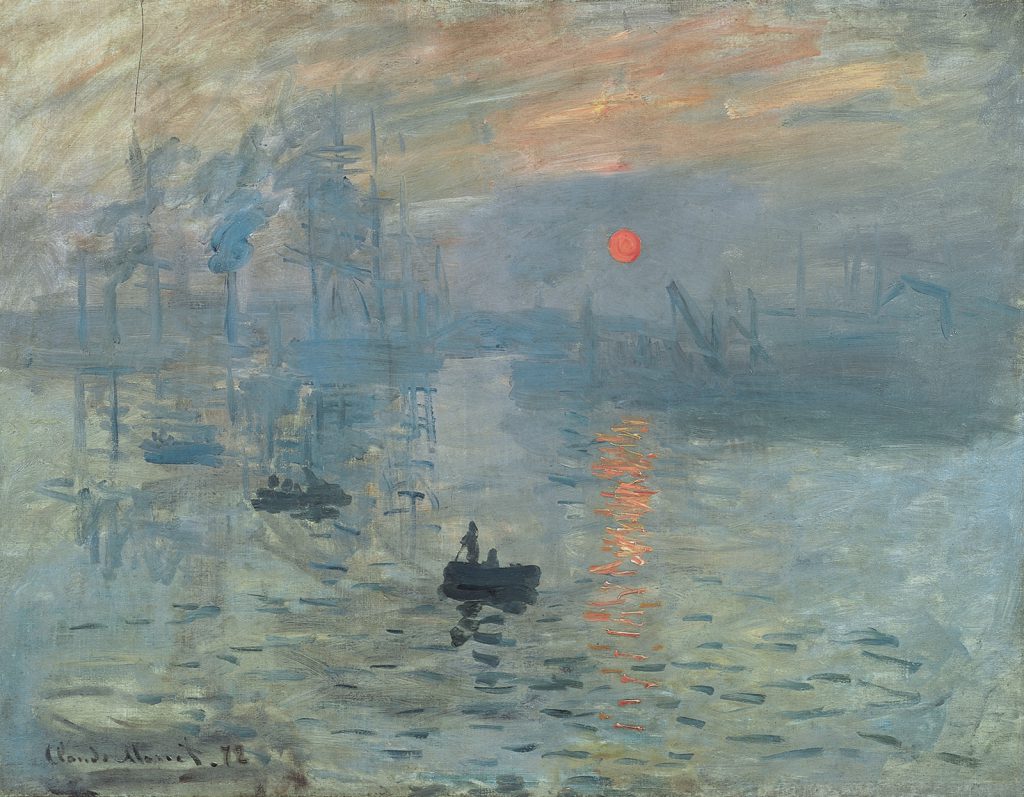
7. Claude Monet, Impression, Sunrise, 1872, Musée Marmottan Monet, Paris, France.
This is the painting from which the whole movement took its name. It depicts the port of Le Havre, Monet’s hometown. Leroy wrote the following about it: “Impression I was certain of it. I was just telling myself that, since I was impressed, there had to be some impression in it – and what freedom, what ease of workmanship! A preliminary drawing for a wallpaper pattern is more finished than this seascape.”
In this course we will talk about:
- What the world that gave birth to Impressionism looked like.
- The most important male and female artists of the movement.
- What influenced the artists of the movement.
- How their art changed over the years.
- How Impressionism grew from ‘zero to hero’.
Undoubtedly, Impressionism is now one of the most popular and loved art movements. This course is not only for those who would like to learn about the basics, but it will also give anyone who has some knowledge and interest in art history a lot of information that will be new to them. In it you will find a general view of the epoch and some in-depth details of the life and the art of the members of the movement. There are also lots of shortcuts and cliches about the Impressionists floating around – we will clarify them too. And we will also add some gossip about the artists themselves (you won’t believe how complicated their relations sometimes were!). But in general, we will focus on their stunning and timeless art.
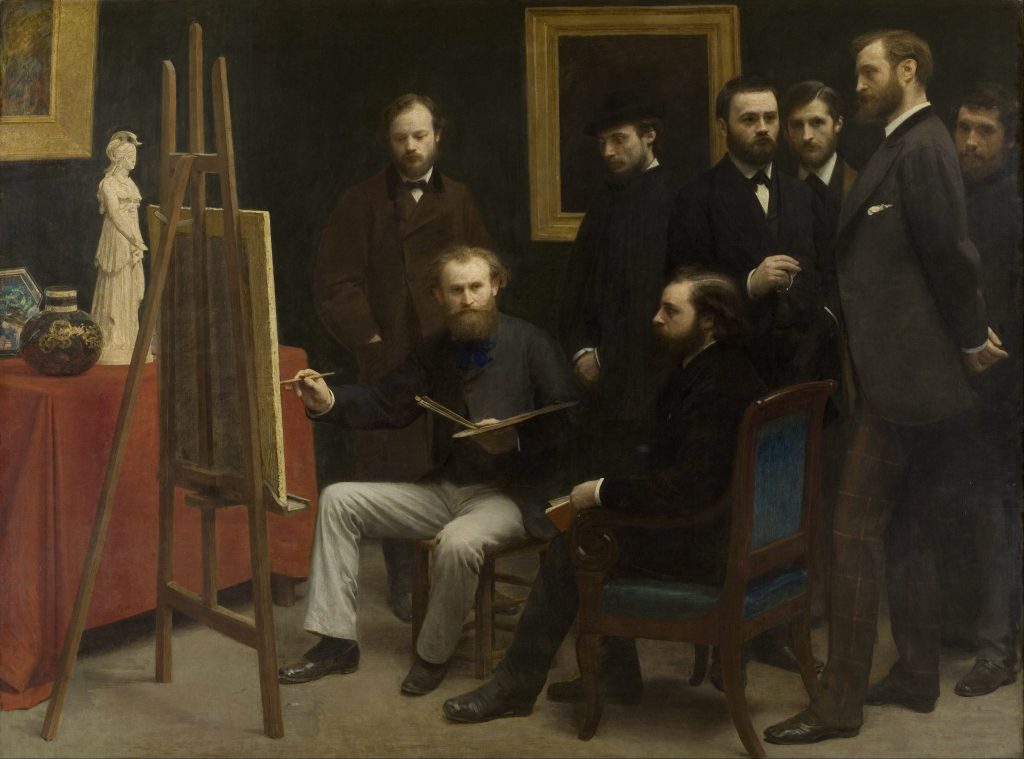
8. Henri Fantin-Latour, A Studio at Les Batignolles, 1870, Musée d’Orsay, Paris, France.
Les Batignolles was the district of Paris where the guru of the future Impressionists, Édouard Manet, and many of the artists who would later join the movement, lived. In this painting, Henri Fantin-Latour, a painter from the circle and a quiet observer of this period, has gathered a number of young artists with innovative ideas around Manet (who is sitting at his easel). Among them are: Auguste Renoir who is wearing a hat; Émile Zola – the spokesman of the new style of painting, holding his glasses in his hand; the tall Frédéric Bazille wearing tartan trousers; and Claude Monet behind him.
Every lesson is designed to take around 20-25 minutes to work through, and each is also filled with images and photos. Take your time. Remember that the masterpieces themselves are the most important 🙂
So, if you’re ready, let’s start. In the first lesson you will learn what the artistic life of the epoch looked like.
We hope you enjoy the ride 🙂
- 15 min
The story of Impressionism starts in Paris in the 1860s. It was then that the four friends who studied together – Claude Monet, Pierre-Auguste Renoir, Alfred Sisley, and Frédéric Bazille –found out that they had something in common: they loved to paint landscapes and scenes from modern life, and at the same time they chafed at following the rigid rules of Academism. The huge and complex scenes of mythological or religious subjects that were being promoted by the French Academy of Fine Arts in Paris, which ruled the artistic scene at the time, just weren’t for them. They wanted to paint what was in front of them, absolutely normal and un-heroic subjects: meadows full of flowers, haystacks, bridges, trains, light effects on water, people chilling out and having fun in public parks, people in the theatres, and women looking after their children.

1. Thomas Couture, The Romans in their Decadence, 1847, Musée d’Orsay, Paris, France.
This painting, which won the Salon of 1847, is typical of the French Academy style from between 1850 and 1900. It is large (472 x 772 cm) and shows a scene from ancient times that represents human behaviour and conveys a moral message.

2. Pierre-Auguste Renoir, Luncheon of the Boating Party, 1880-1881, The Phillips Collection, Washington, D.C., United States.
This is a classic impressionistic scene – regular people outdoors, chilling out. Renoir painted his friends here – we can spot Gustave Caillebotte who sits with his back towards us in his chair, staring across the table at Aline Charigot, Renoir’s future wife, who is cooing to her terrier.
The subjects the Impressionists choose were bold statements. At that time, money, career, and fame belonged to those artists who followed strictly delineated schemes dictated by the Academy. As an artist, if you didn’t want to follow them but still wanted to be somehow recognised, you had to have the nerve and marketing abilities of Gustave Courbet. Luckily, the Impressionists had a lot of nerve and some smart people around them who believed in this “new” art. And later, in the 1890s, they had the United States of America. We will talk about this later.

3. Gustave Courbet, The Bathers, 1853, Musée Fabre, Montpellier, France.
Courbet was a man who caused many artistic scandals. Among them was this painting, which was first exhibited at the Paris Salon of 1853. It was unanimously attacked by art critics for the huge nude woman at its centre and the sketchy landscape background, both of which went against official artistic canon. In 1855, after his painting-manifesto “The Artist’s Studio” had been rejected by the Salon, Courbet decided to organise a personal exhibition alongside the Universal Exhibition in a building which he had built at his own expense and named “The Pavilion of Realism”.
The Impressionist revolution was not only about subjects that were previously absent in art. The basic aim of the Impressionists was to depict on canvas exactly what they saw in a particular moment. To grasp that moment in a painting. To reach that goal, they had to start painting in a new way. They used short, thick strokes of paint to capture the essence of the subject rather than the details. Quickly applied brush strokes gave the illusion of movement and spontaneity. It was all possible thanks to a new technological invention from the 1840s; synthetic paint in tubes. It is hard to believe it now, but until the 19th century all landscapes, even those that look very “natural” and “real”, were created in artists’ studios. Synthetic paints in tubes allowed outdoors to paint… outdoors. En plein air we can say.

4. Berthe Morisot, Young Woman in Grey Reclining, 1879, private collection.
Berthe Morisot was one of the Impressionists and she took the idea of grasping the moment most seriously. Some incredibly sketchy parts of her paintings could be called “abstract”.
The painters were also inspired by photography and Japanese art, which encouraged them to open the composition of their paintings or cut it in a way previously unseen in European art.

5. Gustave Caillebotte, Le Pont de l’Europe, 1876–77, Kimbell Art Museum, Fort Worth, United States.
Gustave Caillebotte has only recently found proper recognition as a first-class impressionist. Previously, he was mostly seen as a supporter and collector of their paintings. The framing of his paintings is clearly inspired by the trends in photography that were taking place at the time.
The keywords of Impressionism are sensuality and transience. How to depict the light of the summer sunset on a Gothic facade? Or the sparkling light reflected in the water of a Venetian canal? The movement of a ballerina spinning in a dance? The Impressionists tried to capture ever-changing reality and perpetuate the subjective, fleeting impressions that left them breathless.

6. Claude Monet, Meules, 1890, private collection.
This painting from Monet’s famous “Haystacks” series was auctioned at Sotheby’s in 2019 for $110.7 million. “Haystacks” is one of the icons of Impressionism and among the greatest examples of how Monet was obsessed with the idea of capturing the moment.
Today the prices of Impressionist paintings reach unbelievable sums ($110.7 million again for “Meules” by Claude Monet!). But it wasn’t always like this. At the beginning, they didn’t earn much money for their art and they were mocked and marginalised. The name of the movement itself was a joke, coined by the art critic Louis Leroy who wanted to make fun of the artists exhibiting their works in Nadar’s famous photography studio in May 1874. He took it from the title of one of Monet’s paintings, “Impression, Sunrise”. However, it is thanks to that painting that the movement took its name and soon became popular not only in France but also in other distant parts of the world, ending up influencing music, literature and even cinema.

7. Claude Monet, Impression, Sunrise, 1872, Musée Marmottan Monet, Paris, France.
This is the painting from which the whole movement took its name. It depicts the port of Le Havre, Monet’s hometown. Leroy wrote the following about it: “Impression I was certain of it. I was just telling myself that, since I was impressed, there had to be some impression in it – and what freedom, what ease of workmanship! A preliminary drawing for a wallpaper pattern is more finished than this seascape.”
In this course we will talk about:
- What the world that gave birth to Impressionism looked like.
- The most important male and female artists of the movement.
- What influenced the artists of the movement.
- How their art changed over the years.
- How Impressionism grew from ‘zero to hero’.
Undoubtedly, Impressionism is now one of the most popular and loved art movements. This course is not only for those who would like to learn about the basics, but it will also give anyone who has some knowledge and interest in art history a lot of information that will be new to them. In it you will find a general view of the epoch and some in-depth details of the life and the art of the members of the movement. There are also lots of shortcuts and cliches about the Impressionists floating around – we will clarify them too. And we will also add some gossip about the artists themselves (you won’t believe how complicated their relations sometimes were!). But in general, we will focus on their stunning and timeless art.

8. Henri Fantin-Latour, A Studio at Les Batignolles, 1870, Musée d’Orsay, Paris, France.
Les Batignolles was the district of Paris where the guru of the future Impressionists, Édouard Manet, and many of the artists who would later join the movement, lived. In this painting, Henri Fantin-Latour, a painter from the circle and a quiet observer of this period, has gathered a number of young artists with innovative ideas around Manet (who is sitting at his easel). Among them are: Auguste Renoir who is wearing a hat; Émile Zola – the spokesman of the new style of painting, holding his glasses in his hand; the tall Frédéric Bazille wearing tartan trousers; and Claude Monet behind him.
Every lesson is designed to take around 20-25 minutes to work through, and each is also filled with images and photos. Take your time. Remember that the masterpieces themselves are the most important 🙂
So, if you’re ready, let’s start. In the first lesson you will learn what the artistic life of the epoch looked like.
We hope you enjoy the ride 🙂
LESSONS
SHOW ALL LESSONS 
Lesson 12: Eva Gonzalès
- 8 min
- 6 masterpieces
The last women Impressionists we need to talk about is Eva Gonzalès. She wasn't mentioned by Geffroy in 1928 as one of the three great female Impressionists, but nevertheless, she was an important member of the movement.


